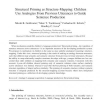Free Online Productivity Tools
i2Speak
i2Symbol
i2OCR
iTex2Img
iWeb2Print
iWeb2Shot
i2Type
iPdf2Split
iPdf2Merge
i2Bopomofo
i2Arabic
i2Style
i2Image
i2PDF
iLatex2Rtf
Sci2ools
COGSCI
2011
2011
Structural Priming as Structure-Mapping: Children Use Analogies From Previous Utterances to Guide Sentence Production
What mechanisms underlie children’s language production? Structural priming—the repetition of sentence structure across utterances—is an important measure of the developing production system. We propose its mechanism in children is the same as may underlie analogical reasoning: structuremapping. Under this view, structural priming is the result of making an analogy between utterances, such that children map semantic and syntactic structure from previous to future utterances. Because the ability to map relationally complex structures develops with age, younger children are less successful than older children at mapping both semantic and syntactic relations. Consistent with this account, 4-year-old children showed priming only of semantic relations when surface similarity across utterances was limited, whereas 5-year-olds showed priming of both semantic and syntactic structure regardless of shared surface similarity. The priming of semantic structure without syntactic structure is...
| Added | 25 Aug 2011 |
| Updated | 25 Aug 2011 |
| Type | Journal |
| Year | 2011 |
| Where | COGSCI |
| Authors | Micah B. Goldwater, Marc T. Tomlinson, Catharine H. Echols, Bradley C. Love |
Comments (0)

